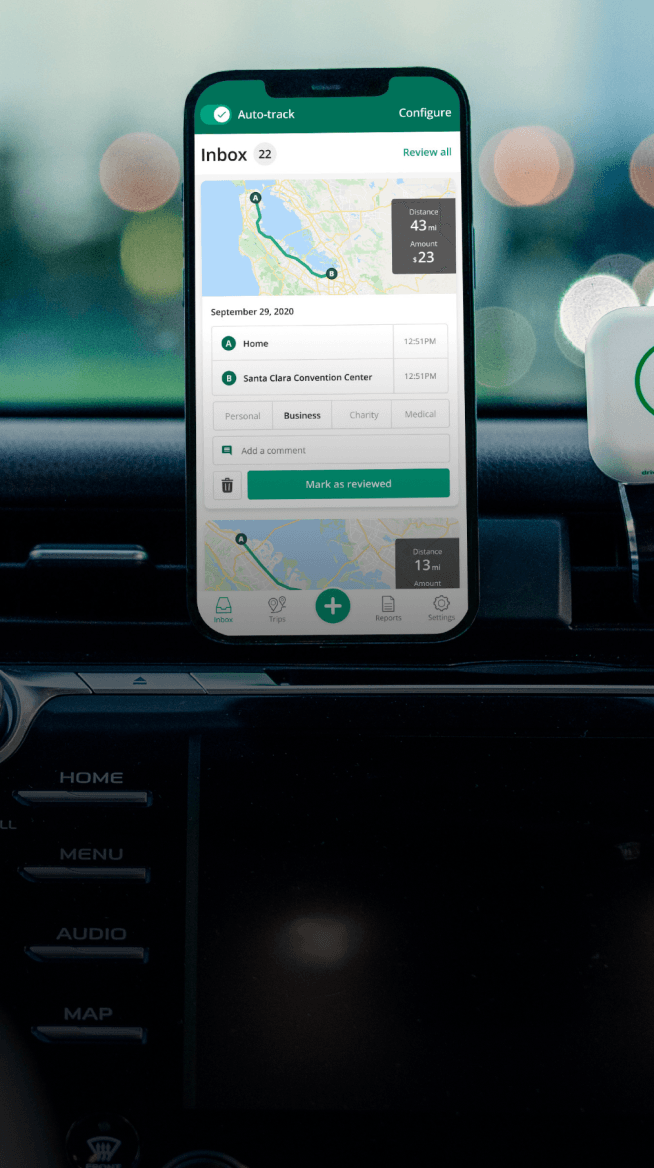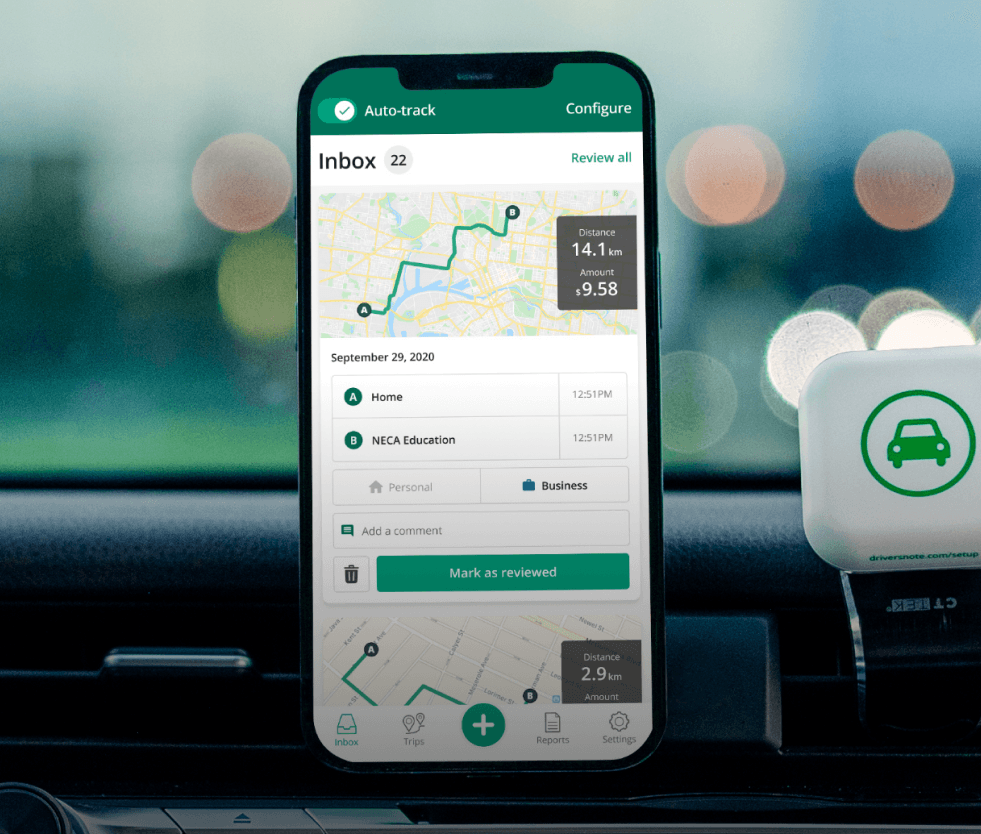Track mileage automatically
Get started
Electric car salary sacrifice: A comprehensive guide for UK employers
In this article
- How an electric car salary sacrifice scheme works
- When is an electric car salary sacrifice a good idea?
- What does an EV salary sacrifice cost? And where can you save?
- How do you choose the right electric car scheme provider?
- Mileage allowance for electric company cars
- Easier approvals and accurate, HMRC compliant mileage logs
- How an electric car salary sacrifice scheme works
- When is an electric car salary sacrifice a good idea?
- What does an EV salary sacrifice cost? And where can you save?
- How do you choose the right electric car scheme provider?
- Mileage allowance for electric company cars
- Easier approvals and accurate, HMRC compliant mileage logs
If you're an employer looking to improve employee benefits, cut carbon emissions, and save on National Insurance contributions (NICs), an electric car salary sacrifice scheme could be a great option.
It seems like a win-win: Your employees get a new electric vehicle (EV) as part of their salary, and you offer a valuable, "greener" perk. But there are challenges you should be aware of.
If you're an employee, you might want to read this blog: Pros and cons of salary sacrifice car scheme.
How an electric car salary sacrifice scheme works
A salary sacrifice scheme allows employees to give up a portion of their gross (pre-tax) salary in exchange for non-cash benefits, such as a company electric vehicle.
For employees, the key advantage is that they receive a benefit they want—such as a car—at a lower cost than if they were to purchase it independently. For employers, the scheme can reduce overall National Insurance Contributions (NICs), as they are not required to pay NICs on the sacrificed portion of the salary.
But how significant are these savings, and what else should your company consider before introducing a salary sacrifice scheme?


Mileage tracking made easy
Trusted by millions of drivers
Automate your mileage log Automate your mileage log

Automatic mileage tracking and HMRC-compliant reporting.
Get started for free Get started for freeWhen is an electric car salary sacrifice a good idea?
Before examining the financial implications of an EV salary sacrifice scheme for the company, let’s consider a few factors you should review before implementing it.
Employee salary range, scheme eligibility, and contract adjustments
Salary sacrifice schemes are not limited to high earners, but you must ensure that an employee's adjusted salary does not fall below the National Minimum Wage after the sacrifice. You should also decide whether to offer the scheme to all employees or a defined group.
Adjust contracts
For employees who opt in, you must formally amend their employment contracts to reflect the change in salary and benefits. You don’t need to notify HMRC before setting up an electric car salary sacrifice scheme. However, once the scheme is active, you must report each car provided to employees.
To ensure correct tax and NIC treatment, your employment contracts should clearly show the changes, including salary adjustments and benefit entitlements, before and after the scheme begins. These variations should also be reflected in the employee’s payslips.
Employee retention and contract duration
In an electric car salary sacrifice scheme, the company formally leases the EVs and then sublets them to employees. This means your company is liable for the lease if an employee leaves before the end of the lease term, typically 2 to 3 years. Early departures could leave you responsible for the outstanding payments. While insurance options are available to mitigate this risk, the associated administration can still be burdensome.
Moreover, the scheme may be less attractive to employees on short-term contracts or those approaching retirement, as they won’t be able to take the vehicle with them when they leave the company.
Integration with your existing benefits package
Consider how this scheme fits your wider employee benefits offering. Salary sacrifice schemes can be complex for employees to understand from a tax and payroll perspective, so you need to make sure you have internal resources (or external partners) to guide them and answer questions.
Driving patterns and sustainability goals
If you have staff with longer commutes or frequent client visits, switching from fuel-based cars to EVs can significantly reduce your company's overall carbon footprint. Offering EVs via salary sacrifice can demonstrate your commitment to Environmental, Social and Governance (ESG) goals while saving employees money on fuel and maintenance.
Access to charging infrastructure
Access to reliable charging facilities is key. Consider installing charging points at the workplace, or maybe including a home charger installation in the lease package. Per HMRC guidance, paying for a charging point at an employee’s home for a company car does not result in a taxable benefit, making this a tax-efficient and attractive perk.
What does an EV salary sacrifice cost? And where can you save?
If you’ve determined that an electric vehicle salary sacrifice scheme would work for your company, the next step is to understand how it will affect your finances and which administrative processes you'll need to follow.
Before we delve into the details and an example calculation, here is a high-level overview of the financial implications related to National Insurance contributions and taxation for companies offering EV salary sacrifice schemes:
- The employee is taxed on the value of the benefit received, which is known as Benefit in Kind (BiK).
- The employer must calculate and report BiK.
- The employer pays Class 1A NIC on the value of BiK.
- However, the employer does not pay NIC on the portion of salary that is sacrificed.
BiK calculation: Which value to use?
Under normal circumstances, when calculating BiK for a company car, you would compare:
- The salary amount sacrificed by the employee
with
- The BiK value of the car, which is calculated based on:
- The car’s P11D value (list price including VAT and optional extras, but excluding registration fees and road tax),
- The vehicle’s CO₂ emissions,
- The applicable BiK rate.
You would then report the higher of the two as the taxable amount.
For EVs, always use the BiK value
When it comes to electric and ultra-low emission vehicles (those emitting ≤75g/km CO₂), HMRC requires that you always use the BiK value, even if it’s lower than the sacrificed portion of the salary. This policy is a deliberate tax incentive to promote greener vehicles.
To further support EV adoption, BiK rates for EVs are significantly lower than those for petrol and diesel vehicles (which typically range from 25% to 37%). For example, the BiK rate for EVs in the 2025/26 tax year is just 3%.
See: EV BiK rates 2023–2028.
To calculate the BiK value, you multiply the P11D value of the car by the BiK rate:
- P11D Value × BiK Rate = BiK value
Example calculation
Lisa chooses an electric car through the salary sacrifice scheme. The car’s P11D value is £35.000, and the BiK rate for 2025/26 is 3%:
- £35.000 × 3% = £1050
£1050 is the BiK value the company must report, and the employee will be taxed.
As mentioned, the company must pay Class 1A NIC on this BiK amount. For 2025/26, the Class 1A NIC rate is 15%.
- £1050 × 15% = £157.50
Calculating NIC savings
Although the company pays £157.50 in NIC for the BiK, it saves NIC on the sacrificed salary:
- Annual salary sacrificed: £6000 (£500/month)
NIC saved on sacrificed salary:
- £6000 × 15% = £900
Net employer NIC savings
| Description | Amount |
| NIC saved on salary | £900 |
| NIC paid on BiK (Class 1A) | £157.50 |
| Net NIC savings per employee | £742.50 |
By offering an EV through a salary sacrifice scheme, the company in this example can save £742.50 per year in employer NICs per participating employee.
Always consult your professional legal, tax, or accounting advisor for specific, tailored legal and tax advice for your business.
The HMRC has also created an online calculator where companies can work out an employee's National Insurance contributions.
Also read: HMRC’s guide for employers.
How do you choose the right electric car scheme provider?
If the numbers make sense and the scheme conditions fit your company, the next step is selecting a scheme provider. You’ll also find many different providers as they have become more popular. This means that with some research, you should be able to find a provider and a package that matches your company.
Typically, your HR department will look into areas such as:
Lease costs and financial terms
- Total lease cost: Compare the monthly or annual costs, ensuring they are competitive.
- Inclusions: Verify if the costs include maintenance, servicing, insurance, and breakdown cover.
- Hidden fees: Check for any additional charges, such as administrative or early termination fees
Budget and range of available cars
- Vehicle selection: Ensure the provider offers a range of electric vehicle models that meet your company’s and employees’ requirements.
- Budget compatibility: Confirm that the options available fit within your budgetary constraints.
Flexibility in contract terms
- Contract duration: Understand the typical lease lengths (usually 2–3 years) and whether shorter or longer terms can be negotiated.
- Early exit options: Look into conditions for early termination and how these are managed.
Contract transparency and legal conditions
- Terms and conditions: Review the provider’s contract carefully for clarity on responsibilities, renewal terms, dispute resolution, and penalties.
- Data protection: Ensure the provider adheres to data protection standards, especially if their systems will handle sensitive employee information.
Mileage allowance for electric company cars
In most schemes, the agreement will not cover running costs like electricity.
Luckily, the company can reimburse all business-related driving expenses tax-free. Employers can use the HMRC advisory fuel rates to reimburse all fuel costs for business travel in company cars, whether employees use petrol, LPG, diesel, or electric vehicles.
The advisory fuel rate for EV company cars is currently 7p per mile as of March 2025.
If you choose not to reimburse mileage, or reimburse below the 7p rate, let employees know they can claim the difference through Mileage Allowance Relief (MAR) on their tax return.
Easier approvals and accurate, HMRC compliant mileage logs
If several employees claim mileage reimbursement, an automatic mileage log like Driversnote helps simplify logging, reporting and approvals. It's also fully HMRC compliant.
Our Teams solution streamlines the approval process and reduces admin time, making it easy to manage business travel expenses accurately and efficiently.

Tired of logging mileage by hand?
Effortless. HMRC-compliant. Liberating.
Top posts
- HMRC advisory fuel rates 2025
- Automate mileage tracking in healthcare with Driversnote Teams UK
- Driversnote Teams vs MileIQ for teams
Related posts
Benefit in kind (BiK) tax on company cars
Latest update: 27 March 2025 - 2 min read
Find out how BiK tax on company cars is calculated and the current and future HMRC rates than apply.
HMRC mileage claim in 5 steps
Latest update: 14 February 2025 - 2 min read
See the 5 simple steps to claiming HMRC Mileage Allowance Relief on Self Assessment in 2025/26 as a self-employed or an employee.
VAT on mileage claims: How to calculate and claim as an employer
Latest update: 26 March 2025 - 2 min read
Guide for employers: learn how to claim VAT on business mileage, what you can and can't claim, and how to calculate your VAT savings.

.svg)